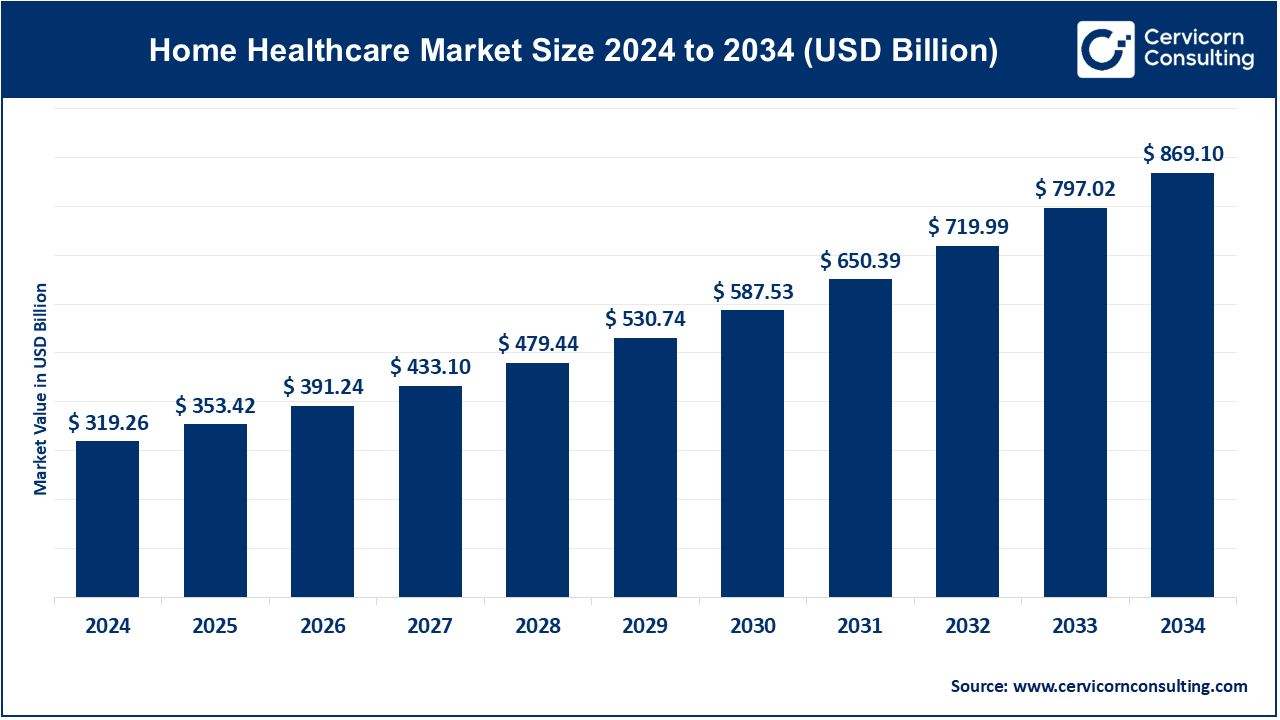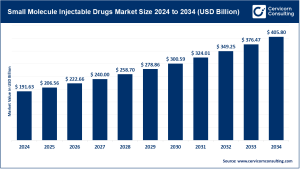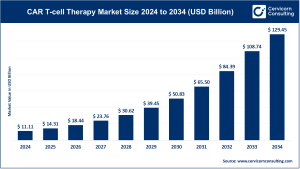What is the Home Healthcare Market?
The global home healthcare market was valued at USD 319.26 billion in 2024 and is projected to reach USD 869.10 billion by 2034, growing at a CAGR of 10.7% from 2025 to 2034.
The home healthcare market encompasses a range of medical services provided to individuals at their homes, rather than in traditional healthcare settings like hospitals or clinics. These services include skilled nursing care, physical therapy, personal care assistance, and the management of chronic conditions. The market is driven by factors such as an aging population, increasing prevalence of chronic diseases, and advancements in medical technology that facilitate remote monitoring and telehealth services.
Market Trends
Telehealth Integration: The adoption of telehealth services has surged, allowing patients to receive consultations and follow-up care remotely. This trend has been accelerated by the COVID-19 pandemic and continues to be a significant aspect of home healthcare.
Wearable Health Devices: Devices such as smartwatches and glucose monitors enable continuous monitoring of health metrics, facilitating proactive management of chronic conditions and enhancing patient engagement.
Artificial Intelligence (AI) in Diagnostics: AI algorithms assist in analyzing patient data to predict health trends, aiding in early detection and personalized treatment plans. This integration improves diagnostic accuracy and patient outcomes.
Personalized Care Plans: There’s a growing emphasis on customized healthcare services tailored to individual patient needs. Personalized care plans improve patient satisfaction and adherence to treatment protocols.
Home-Based Rehabilitation Services: Post-surgical and post-stroke rehabilitation services are increasingly being provided at home, enhancing recovery and reducing healthcare costs.
Get a Free Sample: https://www.cervicornconsulting.com/sample/2342
Market Dynamics
Drivers: Aging Population – A significant increase in the elderly population worldwide is leading to higher demand for home healthcare services. Chronic Disease Management – The rise in chronic conditions such as diabetes and hypertension necessitates continuous care, often best provided at home. Cost-Effectiveness – Home healthcare services are more affordable compared to hospital stays, making them an attractive option for patients and healthcare systems. Technological Advancements – Innovations in medical devices and communication technologies facilitate efficient home-based care. Government Policies – Supportive policies and reimbursement models are encouraging the growth of home healthcare services.
Restraints: Regulatory Hurdles – Varying regulations across regions can complicate the delivery of home healthcare services. Technology Adoption – Older adults may face difficulties in using advanced healthcare technologies. Workforce Shortage – There’s a growing need for trained healthcare professionals to provide home-based care.
Opportunities: Market Expansion – Emerging markets present new opportunities for home healthcare services. Technological Innovations – Development of user-friendly health technologies can enhance service delivery. Policy Support – Governments are increasingly recognizing the value of home healthcare, leading to favorable policies and funding.
Challenges: Data Security – Ensuring the privacy and security of patient data in digital health platforms. Interoperability – Integrating various health technologies and platforms for seamless service delivery. Quality Assurance – Maintaining consistent quality of care across diverse home healthcare settings.
Regional Analysis
North America: North America leads the global home healthcare market, holding a significant market share. Factors contributing to this dominance include a large aging population, high prevalence of chronic diseases, and advanced healthcare infrastructure. The region also benefits from supportive government policies and reimbursement models.
Europe: Europe exhibits steady growth in the home healthcare sector, driven by an aging population and increasing healthcare costs. Countries like Germany and the UK are investing in home-based care models to improve patient outcomes and reduce hospital admissions.
Asia-Pacific: The Asia-Pacific region is experiencing rapid growth in the home healthcare market. Countries like Japan and China are witnessing a surge in demand due to aging populations and urbanization. However, challenges such as regulatory complexities and varying healthcare standards need to be addressed.
Middle East & Africa: The Middle East & Africa region shows potential for growth, particularly in countries with increasing healthcare investments. However, the market is still developing, and factors like infrastructure development and policy support are crucial for expansion.
Latin America: Latin America presents opportunities for home healthcare services, especially in countries with rising healthcare needs and urbanization. However, economic factors and healthcare disparities pose challenges to market growth.
Recent Developments
Partnerships and Collaborations: Companies are forming strategic partnerships to expand their service offerings and reach. For instance, collaborations between home healthcare providers and technology firms aim to integrate advanced monitoring solutions into home care services.
Product Launches: The introduction of new medical devices and software solutions tailored for home use is enhancing the quality and efficiency of home healthcare services.
Regulatory Changes: Governments are revising healthcare policies to support home-based care models. Changes in reimbursement policies and regulations are encouraging healthcare providers to adopt home healthcare services.
Technological Advancements: Continuous innovation in telehealth platforms, wearable devices, and AI-powered diagnostics is transforming the home healthcare landscape, making care more accessible and personalized.
For more detailed insights and data, you can visit the original source: Cervicorn Consulting – Home Healthcare Market
Read: Clinical Decision Support Systems Market Growth, Trends, and Opportunities 2025 to 2034


